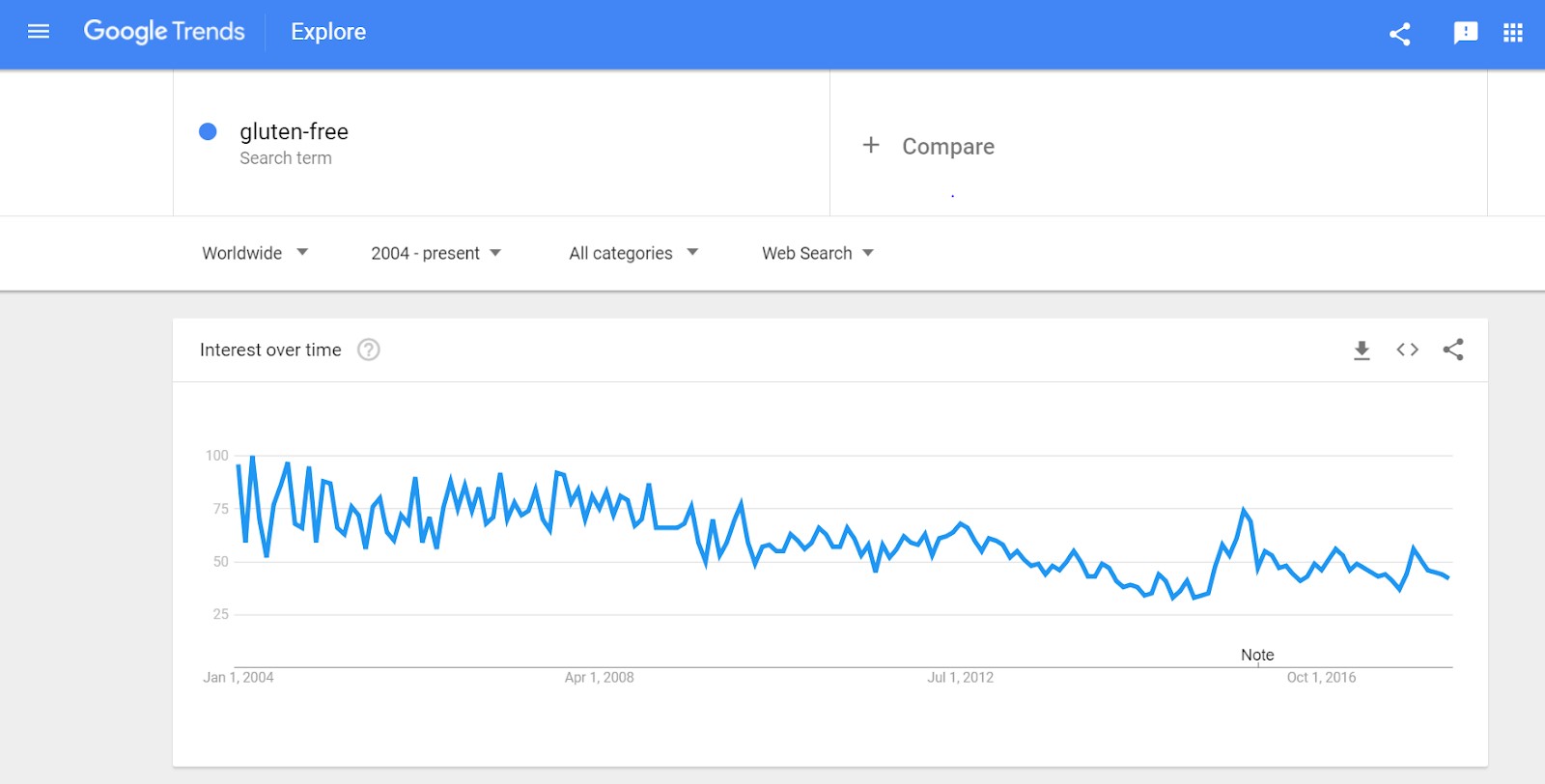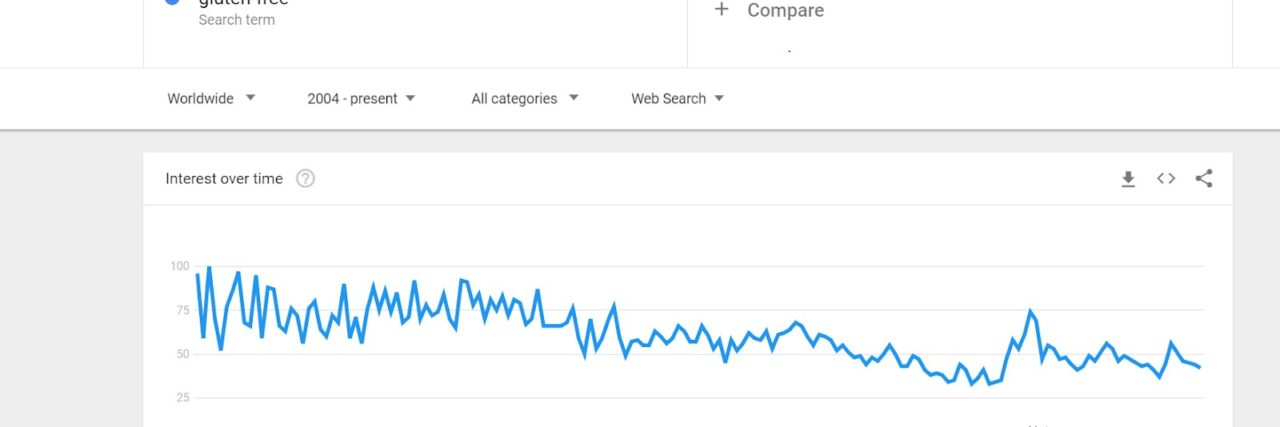For years now, the gluten-free trend has been both the bane and boon of my existence. I’m sure others with celiac disease, or non-celiac gluten sensitivity, can relate. On the one hand, we’ve been the butt of a cultural joke — we’re too picky, too whiny, too vocal, too different. There have been countless think pieces on this side of the gluten-free trend, but many have failed to address the other side of the coin. With this trendiness, we’ve enjoyed an increase in availability, quality, and variety of gluten-free products.
I received my diagnosis in 2005, when gluten-free wasn’t even on the tip of anyone’s tongue — not even my local doctor has it on her radar After a nine-year journey of painful, troubling symptoms, a specialist many miles away from home finally diagnosed me.
Gluten-free foods were crumbly from grainy millet and had an off-taste from the then-commonly used bean flours. As a pre-teen at the time, I was regularly made fun of for the contents of my packed lunches. And forget trying to go out to eat — there were positively no options within a 50-mile radius.
Even worse, my diagnosis came at a time when the internet wasn’t as robust, so finding information or social connections was extremely difficult. It’s no wonder, then, that those were, in my mind, some dark days.
While the comments in mainstream media regarding the gluten-free diet have been, admittedly, painful, I’ve also learned how to let them roll off my shoulders over the years. While a careless comment in a talk show or an insensitive commercial may receive their 5 seconds of fame, I’ve come to realize they are insignificant in the grand scheme of gluten-free awareness.
With the help of organizations like Beyond Celiac, which focuses on awareness and advocacy, we’re leaps and bounds away from the dark days of 2005. As such, I’ve had the luxury to turn my focus to foods that not only sustain me but also ones that bring me joy. Just a few years ago, the gluten-free offerings at grocery stores and restaurants, alike, seemed to expand at a pace I’d never be able to keep up with. I delighted in the indulgence of a real, honest to goodness fried donut, or the occasional juicy burger on a robust, flavorful bun.
But lately, I’m noticing a disturbing trend in the other direction. From tweets announcing the discontinuation of Starbuck’s gluten-free breakfast sandwiches — on the second day of Celiac Awareness Month, no less — to headlines shouting “Van’s recalls gluten-free waffles it says may actually contain gluten,” I’ve been feeling my spidey senses tingling.
Consider, also, the radio silence from Aldis, which typically makes a big deal out of Celiac Awareness Month with gluten-free goodies galore. Add in the carts upon carts of discounted gluten-free foods from countless brands at my local grocery store because they’re just not selling (not to mention the ever-shrinking gluten-free shelf, which was, not so long ago, a full aisle). Count the restaurants eliminating their dedicated gluten-free menus and replacing them with a few sparse “GF” markings on their regular menus.
That tingling spidey sense is becoming really hard to ignore.
Now, let me preface this by saying I’m not typically one to worry about every minor, passing trend. But, I’ve been quietly watching the signs for the last couple of years, and, it pains me to say it, but it’s looking like we’re on the downswing of the gluten-free trend. But don’t just take my word for it.
Consider this graph from Google Trends, which tracks the popularity of search terms over time:

This graph, surprisingly, shows a higher popularity of the search term “gluten-free” during the early days of my diagnosis, and it just goes downhill from there. Perhaps this is due to increased awareness, which lessens the need to conduct Google searches in a desperate, last-ditch attempt to find answers for yourself.
We also saw a smaller resurgence in popularity at the end of 2015, when the gluten-free trend — and its naysayers — appeared to be at a fever pitch. But, today we’re nearing the lowest dip in popularity for the search team “gluten-free” in several years. Taking into consideration the, once again, increasingly limited options in grocery stores and restaurants, this dip in the popularity of the search term may indeed be a symptom of a larger problem.
People with celiac disease and non-celiac gluten sensitivity are not, and haven’t been, the target audience for many of the newest gluten-free offerings. Pizza places offering gluten-free crusts, but making no attempts to limit the risks of cross-contact, echo this belief. Now more than ever, it’s clear the gluten-free revolution has been a product of the latest health buzz for people who don’t medically require the diet.
Those who jumped on the gluten-free bandwagon have since come to realize how incredibly difficult it is to strictly maintain the diet and have found the admonition from the rest of the population to be too burdensome. They’ve turned their backs on the trend, leaving those of us without a choice to keep up the sales pace manufacturers and business owners have come to expect for their gluten-free offerings. Unfortunately, with celiac disease affecting only approximately 1 percent of the population, and an equally small portion affected by non-celiac gluten sensitivity and other gluten-related disorders, this sales pace is impossible to maintain.
And thus, with lower profits for goods that require more oversight, regulation, and special, expensive ingredients, these entities have, one by one, begun pulling the plug. I fear we’re going to see more and more of the products — the ones that have finally made meals a pleasant experience again — will disappear without a trace.
That is, unless we, as a community do something about it. I urge you, as a patient, parent, friend, physician, or ally of celiac disease and other gluten-related disorders, to take a stand. Write letters to your favorite gluten-free manufacturers to tell them how much you appreciate their efforts to provide safe, tasty food. Take part in a clinical trial to help advance a cure. Donate to your favorite advocacy group in support of their cause. Become a patron of a local restaurant that takes the gluten-free diet seriously (and don’t forget to tip well and leave positive reviews!).
We must make our voices heard to evoke any sort of positive change. In that spirit, I’ll be writing letters to some of the companies mentioned above, asking them to take our disease seriously, to continue providing us with the products we’ve come to love, and to help us in our efforts to raise awareness by choosing not to make jokes out of these medical conditions anymore. I plan to share any responses I may receive with you and the rest of the gluten-free community. I hope you’ll do the same because I’m eager to hear about the results of your advocacy as well.
Most importantly, these efforts shouldn’t only be made during Celiac Awareness Month. Make an effort to take at least one action a month. Together, we have the ability to turn the tide and make real change.

